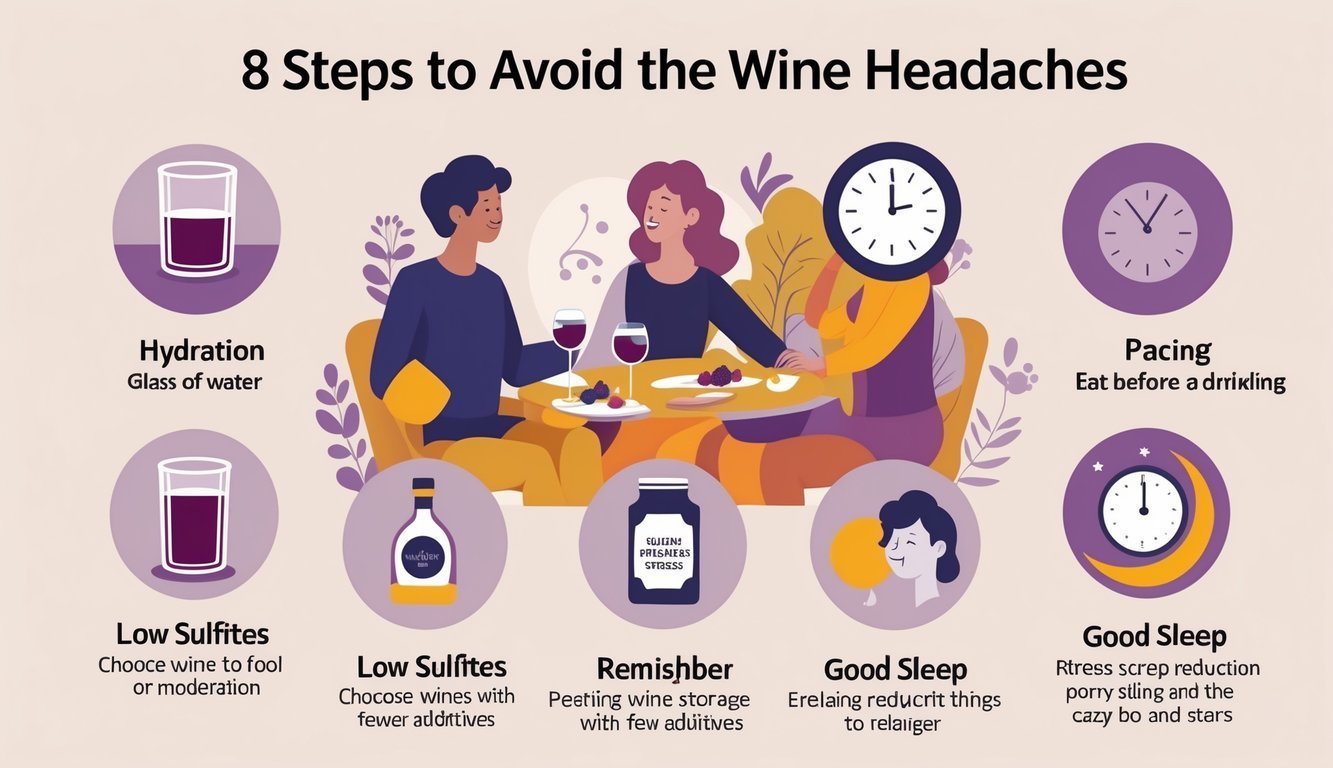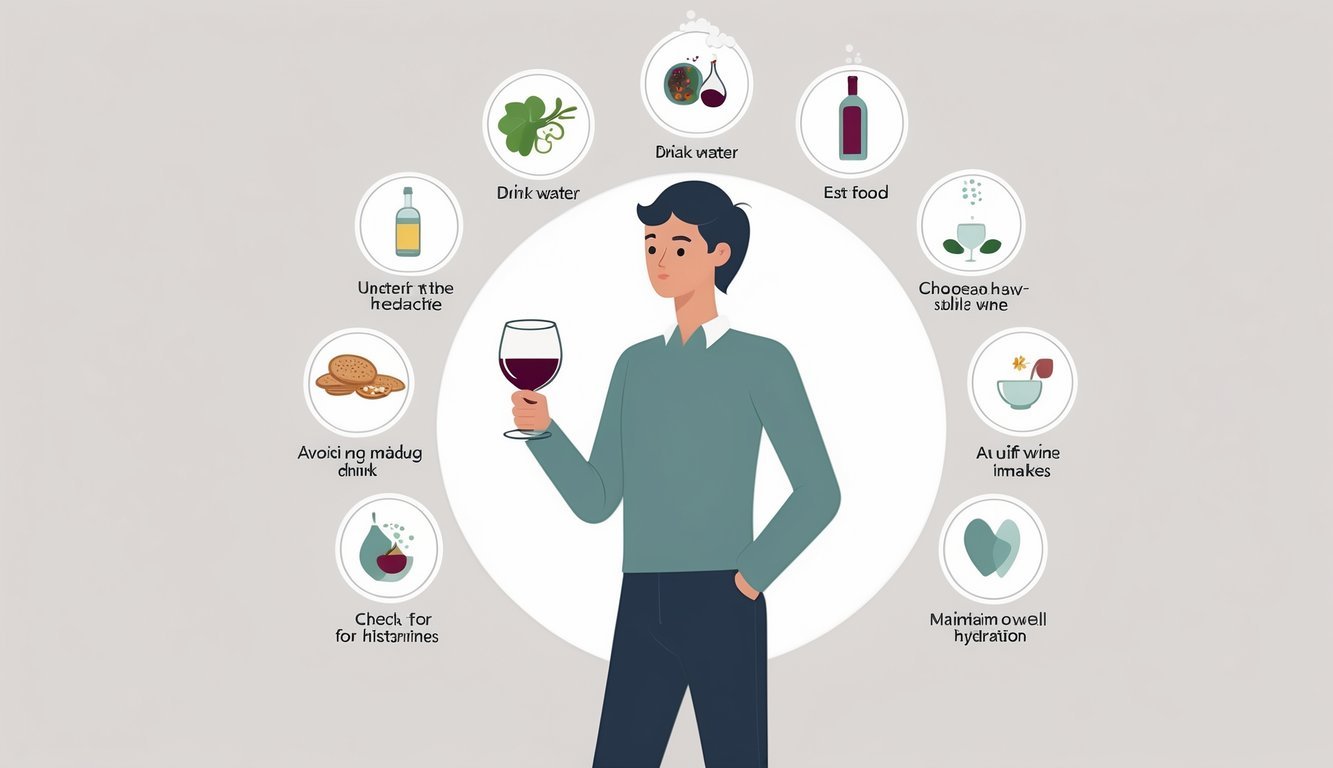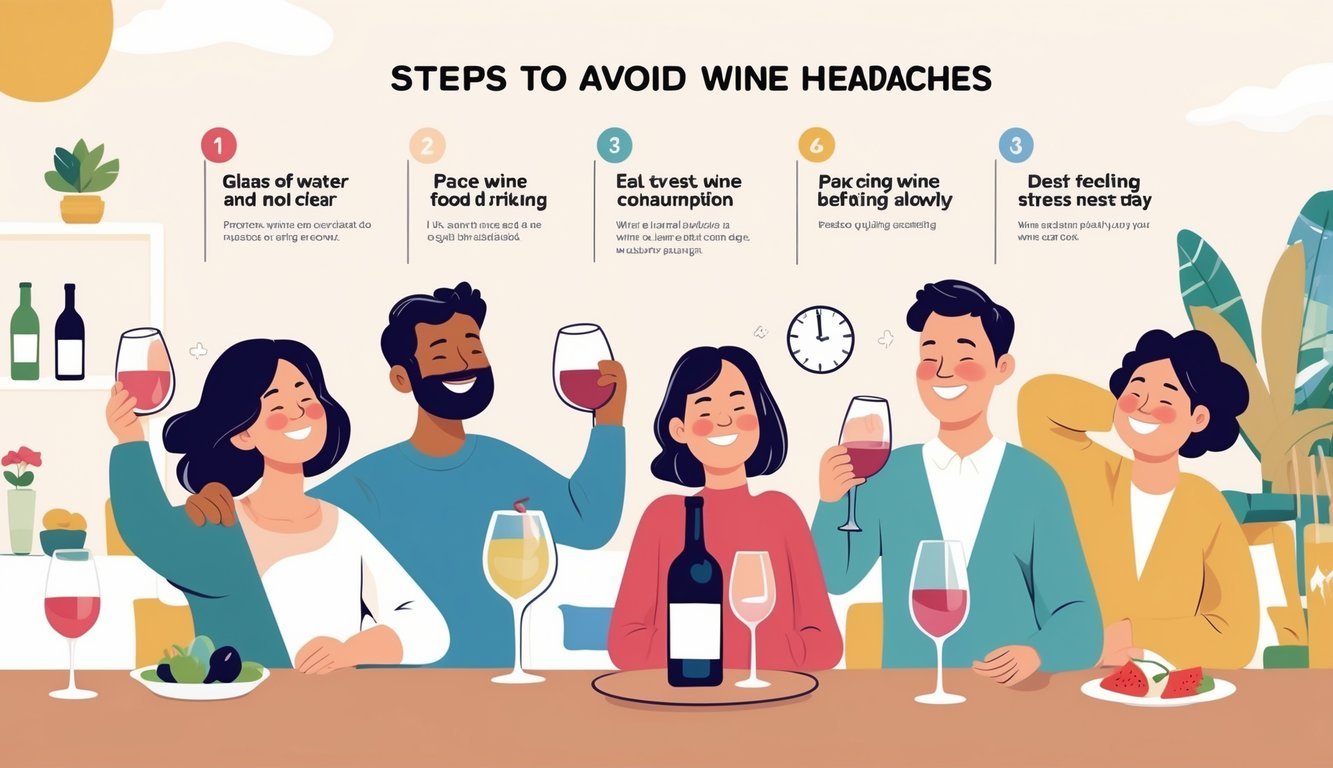PsychNewsDaily Publishers
100 Summit Drive
Burlington, MA, 01803
Telephone: (320) 349-2484
PsychNewsDaily Publishers
100 Summit Drive
Burlington, MA, 01803
Telephone: (320) 349-2484
Wine headaches can be minimized by choosing lower alcohol wines, staying hydrated, eating beforehand, and avoiding cheap or overly sweet options.

Wine headaches can ruin a perfectly good evening before you know it. You really don’t need to give up wine to dodge these headaches—just a few tweaks can make all the difference.
If you pay attention to what you drink, and prep a little, you’ll probably lower your odds of getting a headache.
Wines come packed with stuff like alcohol, sugar, histamines, and sulfites, and any of those might set off a headache. If you drink wine with food, stay hydrated, and pick bottles with less alcohol or fewer additives, you’ll probably notice a difference.
These small steps help your body handle wine better and might save you from that next-day pain.
If you want to enjoy wine without worrying about headaches, you’ll find these tips pretty practical. Your next glass might be all about pleasure, not pain.

Wine headaches show up for a bunch of reasons—what’s in the wine, how your body reacts, and even the winemaking process. The type of wine you drink and its ingredients can make a big difference.
Certain chemicals in wine are more likely to set off headaches. Acetaldehyde, which forms during fermentation, builds up and can feel like a headache trigger.
Biogenic amines, like histamine, can mess with blood flow and cause reactions that lead to headaches.
Phenolic compounds, such as quercetin, come from grape skins and might irritate some people. Red wines usually have more of these because the skins stay in during winemaking.
Cheaper reds often have more of these irritants, probably due to shortcuts in fermentation. Drinking on an empty stomach makes things worse since your body absorbs everything faster.
Red and white wines aren’t equal when it comes to headaches. Red wine has more tannins and phenolic compounds since it’s fermented with the grape skins. These tannins can trigger your body to release histamine, which might cause a headache.
White wine skips the skins, so it ends up with fewer tannins. For some people, this means fewer headaches, but white wine still has sulfites and sugar, which can be a problem.
Because red wine has more of these headache-linked compounds, lots of folks notice red wine headaches more. Still, if you’re sensitive, even white wine can be trouble.
Winemakers use sulfites to keep wine fresh and stop spoilage. Most wines have sulfites, but unless you’re allergic, they probably aren’t the real culprit behind your headache.
Tannins come from grape skins, seeds, and stems, giving wine its bitterness and dryness. If you react to tannins, especially in reds, you might feel it in your head.
Sugar sweetens wine, but too much can spike and crash your blood sugar, sometimes causing headaches. Sweeter wines might be riskier.
If you know how these things affect you, you can pick wines that are less likely to cause problems. Go for lower tannins and sugar, and don’t stress about sulfites unless you know you’re sensitive.

Wine headaches show up for all sorts of reasons—how much you drink, what you pick, and your own body’s quirks. What you eat, how much water you drink, and the wine you choose really matter.
Here’s how you can handle these factors and enjoy your wine without the pain.
Wine dehydrates you because alcohol makes you pee more. That’s a recipe for headaches.
Drink plenty of water before you start, and keep a glass close while you sip your wine.
Try to match every glass of wine with a glass of water. This keeps your body balanced and helps prevent those dehydration headaches.
If you get thirsty or dizzy, don’t wait—just drink more water.
Stronger wines (think above 13% alcohol) often lead to worse headaches. If you stick to wines with 12% or less, you’ll probably do your head a favor.
Lower alcohol means your liver can process it more easily. That cuts down on acetaldehyde buildup, which is a headache trigger.
Check the label for alcohol content and go for lighter wines if headaches are a problem.
Drinking too much too fast pushes your chances of a headache way up. Your body can only handle so much alcohol per hour.
If you drink slowly, your liver has time to keep up. Listen to your limits—if you get headaches after a couple of glasses, don’t force it.
Take breaks and pace yourself. It’s not a race.
Some wines just have more headache triggers. Heavy reds usually have more tannins and histamines, which can cause headaches if you’re sensitive.
White wines and lighter reds usually have less of these. If reds bother you, try switching to whites or lighter reds—you might be surprised how much better you feel.
Cheap wines often come loaded with additives, sugars, and extra sulfites to cover up flaws. These extras can irritate your body and make headaches more likely.
Stick with trusted brands or wines labeled “low sulfite” or “no added sugar.” Quality really does matter here.
Wine on an empty stomach hits harder and faster, making headaches more likely. Food slows down how quickly alcohol gets into your system.
High-protein or fatty foods are best since they help absorb alcohol. Eating before and while drinking helps keep your blood sugar steady and your liver happier.
Some meds, like ibuprofen, can mess with how your body handles alcohol. If you take them without food or too soon after drinking, your stomach might pay the price.
If you need pain relief, take ibuprofen with food and wait at least an hour after drinking. Avoid mixing alcohol with meds that affect your liver or immune system.
Wines have things like sulfites and histamines to keep them tasting fresh, but those can trigger headaches in some people. Sulfites help stop spoilage, but if you’re sensitive, they might cause allergy-like symptoms.
Histamines come from fermentation and are higher in reds. If you get red wine flush or headaches, this could be why.
Look for wines labeled low in sulfites or histamines if you’re sensitive. Test small amounts of new wines to see how you react, and steer clear of overly sweet wines—they just make dehydration and headaches worse.

You can avoid wine headaches by drinking water, eating first, and picking wines with less alcohol and sugar. Some foods and supplements might help, and knowing your own triggers really makes a difference.
Drink water before, during, and after wine. Eat a meal or snack before drinking so alcohol absorbs more slowly.
Pick wines around 13% alcohol or less. Avoid super sweet wines and don’t overdo it.
Foods with magnesium, like nuts or leafy greens, might help. Some people say vitamin B6 supplements make a difference.
Never drink wine on an empty stomach—keeping your blood sugar steady is key.
Wines with more alcohol or sugar often cause more headaches. Reds usually have more histamines and other compounds that can be a problem.
Some folks just react better to whites or rosés.
First, drink water and rest. Over-the-counter painkillers like ibuprofen or aspirin can help.
Sometimes, a cool cloth on your forehead eases the pain a bit.
If you regularly get headaches or migraines within a few hours of drinking wine, you might be sensitive. Try keeping a diary of what you drink and how you feel.
Notice if certain wines bother you more than others.
Try to limit how much alcohol you drink. Mixing different types of drinks? Probably not the best idea.
Make sure you stay hydrated. Eating before you start drinking can help, too.
Pick wines that have less alcohol and lower sugar. If a headache starts creeping in, just stop drinking and grab some water right away.